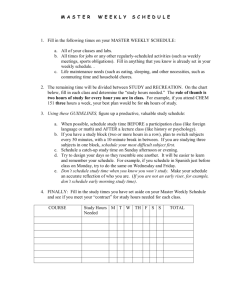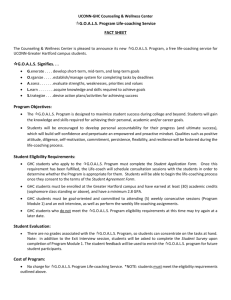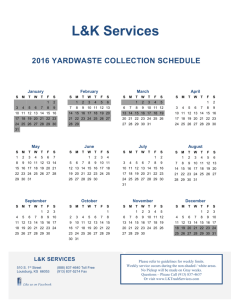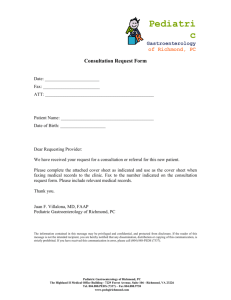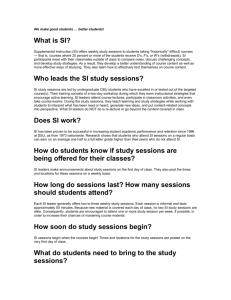Consultation document - background and proposals
advertisement
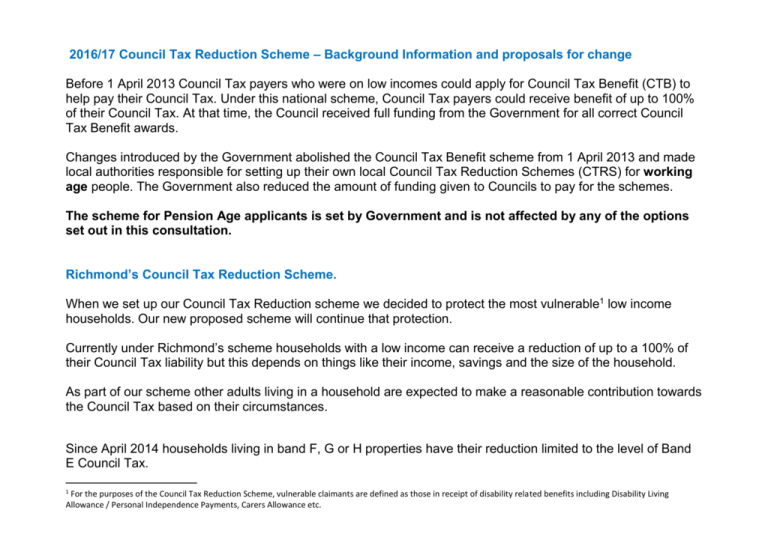
2016/17 Council Tax Reduction Scheme – Background Information and proposals for change Before 1 April 2013 Council Tax payers who were on low incomes could apply for Council Tax Benefit (CTB) to help pay their Council Tax. Under this national scheme, Council Tax payers could receive benefit of up to 100% of their Council Tax. At that time, the Council received full funding from the Government for all correct Council Tax Benefit awards. Changes introduced by the Government abolished the Council Tax Benefit scheme from 1 April 2013 and made local authorities responsible for setting up their own local Council Tax Reduction Schemes (CTRS) for working age people. The Government also reduced the amount of funding given to Councils to pay for the schemes. The scheme for Pension Age applicants is set by Government and is not affected by any of the options set out in this consultation. Richmond’s Council Tax Reduction Scheme. When we set up our Council Tax Reduction scheme we decided to protect the most vulnerable1 low income households. Our new proposed scheme will continue that protection. Currently under Richmond’s scheme households with a low income can receive a reduction of up to a 100% of their Council Tax liability but this depends on things like their income, savings and the size of the household. As part of our scheme other adults living in a household are expected to make a reasonable contribution towards the Council Tax based on their circumstances. Since April 2014 households living in band F, G or H properties have their reduction limited to the level of Band E Council Tax. 1 For the purposes of the Council Tax Reduction Scheme, vulnerable claimants are defined as those in receipt of disability related benefits including Disability Living Allowance / Personal Independence Payments, Carers Allowance etc. Reasons for change Decisions about changes to our Council Tax scheme need to be considered alongside the wider challenges being faced by local authorities. In 2016/17, the money we get from the Government to support our services will be substantially reduced so we need to look at how we deal with this gap in funding. Current estimates are that the Council could lose 50% of its Government Grant funding over the next 4 years. This means that the Council has to look at ways of dealing with these financial pressures. We have identified five options To make changes to the way we work out how much Council Tax Reduction households are entitled to. This will recover some of the loss of Government funding by lowering some households’ entitlement. To fund the Council Tax Reduction scheme by increasing the Council Tax or by raising income from other services. To fund the Council Tax Reduction scheme by reducing expenditure on other services To fund the Council Tax Reduction scheme by using money from our reserves. A combination of the above Our preferred option Our preferred option is to make some changes to the way we calculate Council Tax Reduction to partially cover the loss in Government funding. Why is it our preferred option? Over the last 4 years the Council has had to make difficult decisions about how best to cope with major cuts in Government support whilst trying to safeguard services. Over that time it has implemented over £30m of efficiency projects. During that period, the Council absorbed the 10% cut in Government grant which came with the localisation of Council Tax Benefit and the impact on the scheme of cuts in general grant. During that time, the only change to our original scheme has been to limit the maximum CTR to the level of Band E Council Tax which currently affects just over 100 of the nearly 3,300 Working Age claimants. The estimated level of Council subsidy for the CTR scheme is just under £1.5m per year. Further cuts in Government support could lead to this subsidy rising to an estimated £3.7m by 2019/20. Richmond’s CTR scheme is amongst the least punitive schemes in London. We believe that the CTR scheme should broadly reflect the intentions of the Governments Welfare Reforms and not act as a replacement for reductions elsewhere. We also believe that it is reasonable, given the increasing costs of the scheme, to ask Working Age claimants to make a contribution. Comments on the other options Raising Council Tax might seem like an easy option but the Council has made a commitment to hold increases in Council Tax down. There would also be pressure from all other service areas to do the same thing. We must also remember that the Council would have to hold a referendum if it wanted to increase Council Tax by more than 2%. The Council has increased fees for most of its services by more than inflation for a number of years placing additional costs on those service users. The Council does not think that it is reasonable to load further pressure on to those charges and there is also a risk that if prices rise too much, then demand and income could actually fall. Use of reserves can only be a short term solution to any funding issue. Once they are used, alternative funding has to be found. Use of reserves is, at best, a way to postpone making the difficult decisions required. It should also be noted that many of the Council’s reserves are already earmarked for important projects which might be put at risk if the reserves were used for other purposes. Changes we are proposing The proposal is that all working age residents eligible for Council Tax Reduction who are not vulnerable should be required to pay a minimum of 5% of their Council Tax themselves. The change that we are proposing to make to our Council Tax Reduction Scheme would not affect Pensioners or those residents that are treated as Vulnerable under our scheme. The outcome of doing this would be: That every working age person who is not vulnerable is required to pay at least the minimum amount of 5%; Richmond’s scheme would remain generous compared to many others in London Other consequences of doing this would be: There may be additional collection issues and costs for the Council; Other Council Tax payers will continue to meet the bulk of the loss of Government funding for the scheme Examples When working out whether someone qualifies for help through our CTRS, we first calculate their “applicable amount” (see Definitions below). Next, we calculate their income and, in the case of couples, that of any partner. We also apply any relevant “disregards” (see Definitions below) If the income after applying any “disregards” is below their applicable amount, then the applicant can receive maximum help (100% of their Council Tax Bill, or the equivalent of Band E if the applicant lives in a Band F, G or H property). However, if there are any additional adults living in the household, a “non-dependant” deduction (see Definitions below) may be applied. If the income after applying any “disregards” is above their needs (applicable amount) the maximum award will reduced by 20 pence for every £1 excess income (this percentage reduction is called a taper i.e. a 20% ‘taper’). We then make any deductions for non-dependants where applicable (see Definitions below). Below is an example to illustrate how the CTRS is currently calculated for a couple with 2 children and how the proposed change will affect them (increase of £0.68 per week): Weekly calculation 2015/16 Proposed weekly calculation @ 5% minimum Applicable amount calculated as: Couple, at least one member of the couple over 18 (both under pension age) £111.45 £111.45 Child 1 £64.99 £64.99 Child 2 £64.99 £64.99 Family Premium £17.40 £17.40 £258.83 £258.83 £263.00 £263.00 Excess income (difference between applicable amount – Needs Allowance – and earned income). £4.17 £4.17 20% taper (£4.17 x 20%) £0.83 £0.83 £30.26 £30.26 Minimum Payment £0.00 £1.51 Weekly Council Tax to pay £0.83 £1.51 Applicable Amount The applicable amount is compared against the income as follows: Earned income (net) and after applying the couples earnings disregards of £20.00 and the additional earnings disregard of £17.10 Band D property weekly Council Tax liability This example looks at the impact on a single parent with 2 children currently receiving full Council Tax Reduction (increase of £1.51 per week): Proposed weekly calculation @ 5% minimum Weekly calculation 2015/16 Applicable amount calculated as: Lone Parent £71.00 £71.00 Child 1 £64.99 £64.99 Child 2 £64.99 £64.99 Family Premium £17.40 £17.40 £218.33 £218.38 £200.00 £200.00 Excess income (difference between applicable amount – Needs Allowance – and earned income). Nil Nil 20% taper Nil Nil £30.26 £30.26 Minimum Payment £0.00 £1.51 Weekly Council Tax to pay £0.00 £1.51 Applicable Amount The applicable amount is compared against the income as follows: Earned income (net) and after applying the couples earnings disregards of £20.00 and the additional earnings disregard of £17.10 Band D property weekly Council Tax liability Applicable Amount allowance This example looks at the impact on a single parent with 2 children already paying towards their Council Tax (no change): Weekly calculation 2015/16 Proposed weekly calculation @ 5% minimum Applicable amount calculated as: Lone Parent £71.00 £71.00 Child 1 £64.99 £64.99 Child 2 £64.99 £64.99 Family Premium £17.40 £17.40 £218.38 £218.38 Earned income (net) and after applying the couples earnings disregards of £20.00 and the additional earnings disregard of £17.10 £324.35 £324.35 Excess income (difference between applicable amount – Needs Allowance – and earned income). £105.97 £105.97 20% taper £21.19 £21.19 Band D property weekly Council Tax liability £30.26 £30.26 £0.00 £1.51 £21.19 £21.19 Applicable Amount The applicable amount is compared against the income as follows: Minimum Payment Weekly Council Tax to pay Definitions Applicable amount – The applicable amount is the amount of money the Council believes an applicant and partner and his or her dependents need to have in order to live. This figure varies depending on the claimant’s personal circumstances (i.e. age and whether they are single or living with a partner). Additional needs are added for each child in the household and members of the household who are disabled or carers. These additional needs are called allowances and premiums in the CTRS. Non-dependant – In broad terms a non-dependant is a grown-up son, daughter, friend or relative who lives in the claimant’s home. The calculation of Council Tax Reduction assumes they will contribute to the household expenses and therefore a non-dependant deduction is taken into account when calculating a claimant’s entitlement to Council Tax Reduction. Earnings Disregards – Some earned income can be disregarded for the purposes of calculating income. The amount of the disregard depends on the circumstances of the applicant Vulnerable claimant – people who receive certain disability related benefits included in their assessment of their entitlement to CTRS will qualify as vulnerable. The definition of vulnerable is not changing. Consultation The Council is required to formally adopt a Council Tax Reduction scheme by 31 January each year to start on 1 April of that year and to consult on any changes to the scheme. This consultation is about our proposals for changes to the scheme for 2016/17 and we want your views on these to help us make final decisions. We are keen to ensure that all Council Tax payers are aware of the changes we have proposed. The Council recognises that any changes will affect some of its residents and wants to get a full range of views on the proposed changes to our local Council Tax Reduction Scheme. We will be seeking the views of: • Existing Council Tax Reduction Discount applicants who may be affected by the proposals • Advocacy / welfare groups • Council Tax payers • Partner organisations which may be affected indirectly such as Richmond Housing Partnership How are we consulting? Given the wide range of residents and groups that we want to consult with, a number of consultation methods are being used: Online consultation Writing directly to those working age households currently receiving Council Tax Reduction who might be affected to invite them to complete the consultation. We will also be seeking the views of: Advocacy / welfare groups Council Tax payers Partner organisations which may be affected indirectly such as Richmond Housing Partnership Whilst the Council recognises that these proposals may affect an individual’s finances it is unable to engage in discussion of individual cases as part of this consultation. Consultation Question We would like your views on our proposal and, in particular whether: You think it is reasonable to balance the burden of funding the scheme between recipients of Council Tax Reduction and Council Tax payers? You think that the 5% contribution is reasonable? Please submit your completed survey by midnight on the 8th January 2016 when the survey closes. To see a copy of the proposal report please follow the following link www.richmond.gov.uk/home/council_government_and_democracy/democratic_processes_and_events/cal endar_of_meetings On the timetable, click on the Cabinet Meeting for 3 December the report forms part of the Agenda reports pack, item 14. Timetable Cabinet agrees to consult on draft scheme 3 December 2015 Consultation 4 December 2015 – 8 January 2016 Findings of Consultation available on Council website January 2016 Final decision on scheme 19 January 2016 Translation advice If you have difficulty understanding this document, please visit the Council's reception at the Civic Centre, Twickenham TW1 3AA, where we can arrange a telephone interpreting service. Please contact us if you need this leaflet in Braille, large print, on audio tape or in another language. Phone: 0208 891 1411 or Minicom: 020 8831 6001. Please submit your completed survey by midnight 8th January 2015 when the survey closes.

